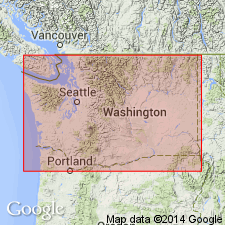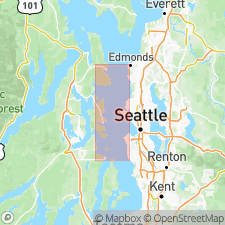
- Usage in publication:
-
- Blakely Harbor Formation
- Modifications:
-
- Original reference
- Dominant lithology:
-
- Conglomerate
- Sandstone
- AAPG geologic province:
-
- Puget Sound province
Summary:
Blakely Harbor Formation. Massive to moderate bedded, dark reddish brown, cobble to boulder conglomerate in well-cemented matrix of coarse-grained, poorly sorted sandstone. Sandstone and conglomerate are composed of subangular to well-rounded clasts of basalt, andesite, hard well-cemented basaltic sandstone, dark-gray siltstone, and a few quartzose and metamorphic rock fragments. Thin layers of lighter gray-brown clay mudstone, carbonaceous siltstone and coal are interbedded. Thickness 1,000 m. Overlies Blakeley Formation. Age is Miocene(?) or Pliocene(?).
Type section: exposures along shore of Blakely Harbor, north along east beach of Bainbridge Island toward village of Winslow, and east offshore at Blakely Rocks, Kitsap Co., west-central WA.
Source: US geologic names lexicon (USGS Bull. 1520, p. 31); GNU records (USGS DDS-6; Menlo GNULEX).

- Usage in publication:
-
- Blakely Harbor Formation
- Modifications:
-
- Age modified
- AAPG geologic province:
-
- Puget Sound province
Summary:
Pg. 72 (fig. 3), 73, pl. (figs. 2b-f). Blakely Harbor Formation. Outcrop section of the Blakely Harbor Formation of Fulmer (1975) is a nonmarine sandstone, conglomerate, and siltstone, cut by faults, and neither base nor top of unit is exposed. In seismic profiles across the Seattle basin (Puget Sound), the Blakely Harbor is bounded by low-angle truncation surfaces. Underlies Quaternary sediments and overlies Eocene to Oligocene Blakely Formation. Seismic reflections of the Blakely Harbor are hummocky and discontinuous with variable amplitudes, consistent with a nonmarine origin. Thickness approximately 3,010 m. Age is Miocene, [based on ages of overlying and underlying units].
Source: Publication.
For more information, please contact Nancy Stamm, Geologic Names Committee Secretary.
Asterisk (*) indicates published by U.S. Geological Survey authors.
"No current usage" (†) implies that a name has been abandoned or has fallen into disuse. Former usage and, if known, replacement name given in parentheses ( ).
Slash (/) indicates name conflicts with nomenclatural guidelines (CSN, 1933; ACSN, 1961, 1970; NACSN, 1983, 2005, 2021). May be explained within brackets ([ ]).

